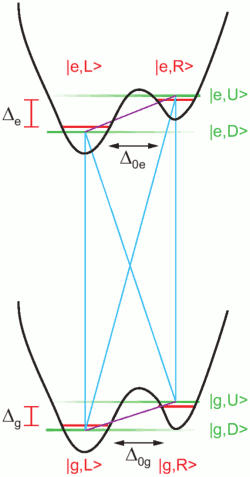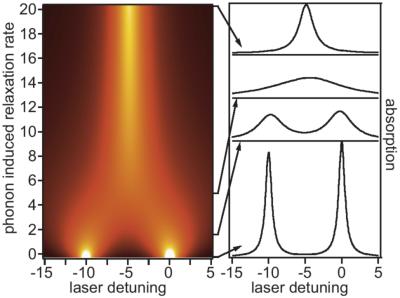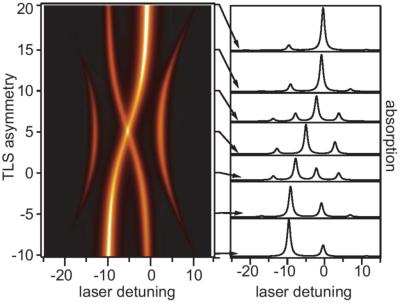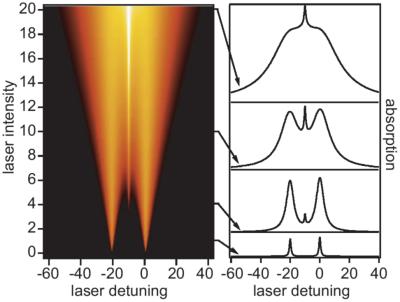At low temperatures the hopping of charges from site to site in weakly conducting systems can be described as a tunneling process. In certain cases this tunneling takes place in an energy landscape that can be simplified by a two-well potential. If a single dye molecule is close to such a tunneling electron their interaction will modify the energy levels of the dye molecule and we should observe a change in its fluorescence excitation spectrum.

Figure 1.
Four-level system consisting of an optical two-level system (OTLS) with a ground |g> and an excited |e> state and a vibronic two-level system (VTLS) with a left |L> and a right |R> state. The VTLS is represented by a two-well potential in each of the states of the OTLS and the localized states are depicted by a thin red line in each of the wells. The VTLS has an energy asymmetry ?g and ?e and a tunneling constant ?0g and ?0e in the ground and excited state of the OTLS, respectively. This coupling leads to the delocalized states up |U> and down |D> which are indicated by the thick green shaded lines. The thin cyan and purple lines indicate possible transitions between the four states; four of them occur at optical frequencies (the cyan ones). The crucial point is the change in potential between ground and excited state, which leads to the existence of four optical transitions instead of two.
In this project, we have performed theoretical evaluations of the spectral lineshape of a single molecule coupled to a single two-level system, which can represent a single charge carrier hopping between two different sites, or a vibrational two-level system (VTLS) in a low-temperature glass [1]. The molecular excitation can significantly modify the tunneling potential of the VTLS, which leads to four possible optical transitions instead of only two when the potential remains unchanged upon excitation. We have carried out a general mathematical treatment of this four level system representing a single optical two-level system (OTLS) coupled to a single VTLS in an arbitrary laser field. Despite its apparent simplicity, the coupled four-level system presents a surprising richness and complexity. Among the several phenomena encountered, we found motional narrowing, cross transitions between different levels of the VTLS, induced by changes of the tunneling potential between the ground and excited OTLS-states, optical pumping and saturation, and nonlinear effects at high laser fields.

Figure 2.
The transition from a double peak at low phonon induced jump rate k in the two-well potential (spectral diffusion) to a single line at high jump rate (motional narrowing). The two lines actually merge, as predicted by the semiclassical sudden-jump model of Kubo and Anderson.
We have shown, that these complex effects give rise to characteristic features in the absorption spectra of single molecules, which compare well with earlier experimental data by Bauer and Kador [2,3].

Figure 3.
Four lines appear in the spectrum as an external parameter (the electric field) changes the asymmetry of the vibrational two-level system
However, more subtle signatures, such as autocorrelations, cross correlations or anticorrelations of fluorescence photons could be sought, in studies similar to that presented by Hettich et al. [4] To model these higher-order functions, one should solve the time-dependent evolution of the density matrix by diagonalizing the tetradic effective Liouville superoperator and expressing the excited-state population as a function of time after measurement of a fluorescence photon, with possible spectral selection. These more complex calculations will be the subject of future work.

Figure 4.
An additional line appears in the spectrum only at high Rabi frequency ? (laser intensity). The line quickly grows proportional to the square of the Rabi frequency, which indicates a two-photon nonlinear process. The line remains narrow and saturates only at very high Rabi frequency.
References
- C. Hofmann, M. Orrit
“Four-Level Optical Lineshape of a Single Molecule Coupled to a Single Tunneling Two-Level System”
J. Phys. Chem. B 110 (2006) 18925-18932 - M. Bauer, L. Kador
“Electric-field effects of two-level systems observed with single-molecule spectroscopy”
J. Chem. Phys. 118 (2003) 9069-9072 - M. Bauer, L. Kador
“Single-molecule spectra split by the interaction with two-level systems (TLSs)”
J. Lumin. 107 (2004) 32-37 - C. Hettich, C. Schmitt, J. Zitzmann, S. Kühn, I. Gerhardt, V. Sandoghdar
“Nanometer Resolution and Coherent Optical Dipole Coupling of Two Individual Molecules”
Science 298 (2002) 385-389


